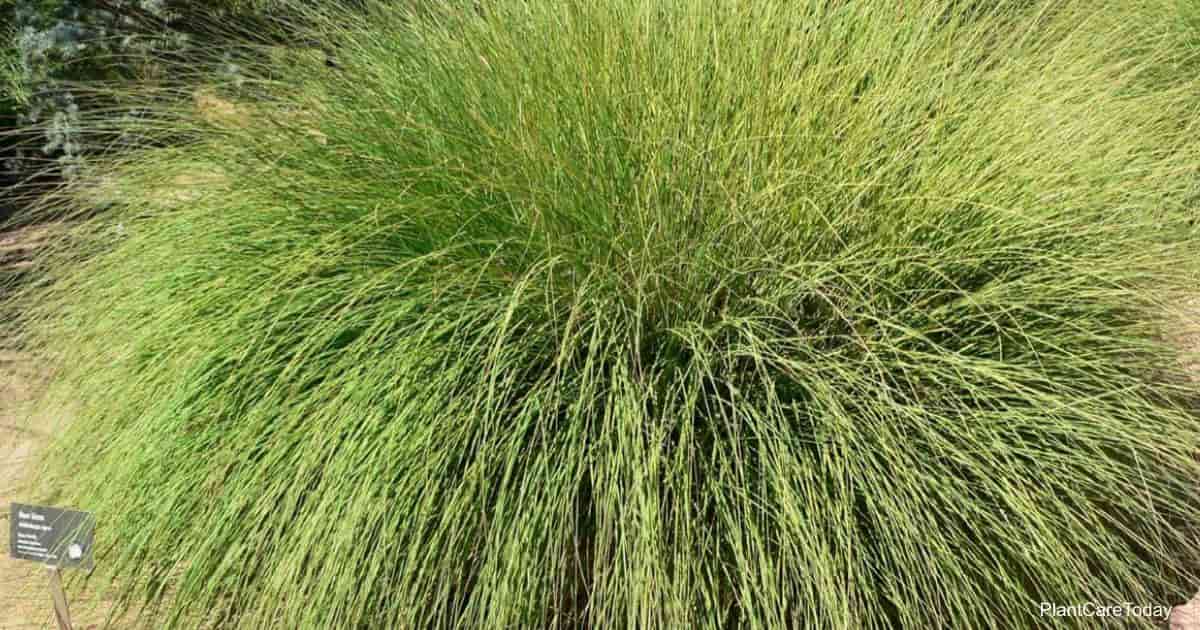Muhlenbergia rigens [Muh-len-BER-gee-a, RIG-ens] is native to Southern California, Northern Mexico, New Mexico, and Texas.
This ornamental grass typically grows in valley grasslands, yellow pine forests, chaparral, and wetland areas.

This perennial bunchgrass is a member of the family Poaceae.
It is commonly called Deer Grass, but it is quite deer resistant.
Muhlenbergia Rigens Care
Growth
Deer Grass grows quite rapidly and can progress from seedling to maturity in a mere two seasons.
This warm-season bunchgrass has long, finely textured, slim, silver-green blades growing in an arching, fountain-like form.
The broad mounds are typically about 3′ feet tall and 4′ feet wide.
Flowering & Fragrance
The flowers are unremarkable.
They appear late in the summer and early autumn on long, very thin, whip-like flower spikes approximately 3′ feet high.
The tiny flowers are pale brown, and the seeds are extremely small.
Light & Temperature
Deer Grass prefers bright, ample, full sun exposure and hot temperatures.
It is winter hardy in USDA hardiness zones 6 through 11.
Watering & Feeding
This bunch grass can do quite well with only winter rains to sustain it; however, if kept in the garden setting, deep, occasional watering will help the plant stay green, attractive and robust throughout the growing season.
Soil & Transplanting
Deer Grass grows well in almost any type of soil as long as it is well-draining.
Plant young plants in the fall to allow them to get the advantage of winter rains.
Grooming & Maintenance
Deer Grass has a naturally contained growth habit.
Its rounded mounds will stay tidy even if you ignore them completely.
Even so, enhance the appearance of the plant with regular watering during the growing season and annual shearing at the end of the growing season.
This will stimulate entirely fresh growth in the springtime.
Other Ornamental Grasses for the Landscape:
How To Propagate Deer Grass
Start Deer Grass from seed late in the winter or early in the springtime.
Set the plants out in the autumn so they can get the benefit of winter rains.
Also, propagate by division.
After shearing back mature plants for the winter months, dig up roots, divide them and relocate them.
They will spring up cheerily come springtime.
Be advised you will need an exceptionally sharp implement to cut through Deer Grass’ tough, fibrous roots.
Deer Grass Pest or Disease Problems
Mammals other than deer may graze on this bunch grass.
Watch out for rabbits and ground squirrels.
Additionally, voles may burrow into the base of mature plants (especially if they have been left unsheared and a lot of thatch has developed).
Voles may also eat immature plants.
In very dry climates, Deer Grass has no disease problems.
In moist climates, fungal infections may be a problem.
Close attention to thinning and grooming will help prevent fungus infections.
Is Deer Grass Toxic or Poisonous?
Deer Grass is not toxic, and in fact, it was a staple food for many Native Americans who ground the seeds to make a flour-like substance which was combined with cornmeal for baking and other culinary purposes.
Is Muhlenbergia Grass Invasive?
Although Deer Grass grows in a very robust manner in its native territories, it does not self-sow very easily and is not considered invasive.
Suggested Muhlenbergia Rigens Uses
This hardy bunch grass is a good choice for mass planting on sloping banks.
Individual plants make nice specimen plants in rock gardens; however, it’s good to keep in mind these plants do reach fairly considerable size, so you’ll need to have plenty of space.